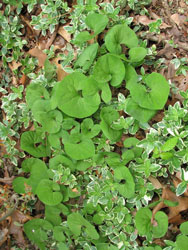Resource Library
Plant of the Week: Wild Gingers
The University of Arkansas System Division of Agriculture does not promote, support or recommend plants featured in "Plant of the Week." Please consult your local Extension office for plants suitable for your region.
Plant of the Week
Wild Gingers
Latin: Asarum canadense

In my shade garden grow several wild gingers, members of the genus Asarum. Over the years, most have spread happily, wheedling their way into nooks and crannies around the garden and into my affection as well. Based on the amount of scientific ink that has been spilled on this group of lowly plants, I'm not the only one who has found them intriguing.
Asarums are temperate groundcovers of the northern hemisphere and occurs widely in North America, Europe and Asia. They belong to the small tropical birthwort family (Aristolochiaceae) that's best known for its unusual "Dutchman's pipe" flowers. The Asarums apparently originated in Asia but had spread across the ancient landmasses before the continents went their separate ways.
The most common and prolific of my wild gingers is Asarum canadense. It's a 6-inch tall creeping groundcover that spreads by means of fleshy, pinkie sized rhizomes, eventually forming colonies several feet across. It produces heart-shaped, deciduous 4-inch wide leaves that appear in early spring and persist until the first hard freezes of fall.
Asarum flowers appear in early spring with the new leaves, but they're easily overlooked because they emerge buried beneath leaves and other debris of the forest floor. They're borne singly at the end of a rhizome and are ½-inch long and wide, fuzzy, brown in color with three reflexed sepals. Though interesting, they're not all that showy.
But amongst botanists, the flowers have caused lots of controversy. Structurally, the flowers are arranged in such a way that it's obvious there should be something out there cross-pollinating them. Everything from slugs to fungus gnats have been proposed, but current research indicates most species are self-fruitful, only rarely being cross-pollinated.
When successfully pollinated, the flowers produce seeds which have a nutritious oily coating called an ‘elaiosome' which ants find irresistible. The ants carry the seeds back to their nests, enjoy their feast and discard the seeds where they come up willy-nilly in the garden.
Botanists have had difficulty defining the limits of the wild ginger genus. The splitters consider only 20 or so species to belong to the genus Asarum, relegating the other 60 species to three separate, closely related genera. The lumpers though seem to be winning the day and modern classification schemes recombine the groups as separate subgenera within the Asarum genus.
Wild gingers have a long list of ethnobotanical uses, not the least of which is as a substitute for the tropical ginger root. Wild ginger has a similar taste to tropical ginger but is only about one third as strong. In addition to its culinary use, it was also used as a part of the Native American pharmacopoeia, treating everything from infections to various kinds of internal ailments. Meriwether Lewis, probably under the instruction of Sacagawea, pounded the roots and leaves of wild ginger to form a poultice which they applied to Joe Potts' swollen and inflamed leg which he cut with a knife in Idaho's Bitterroot Mountains. He quickly recovered.
But in 2001, the Food and Drug Administration issued a warning against using wild ginger in cookery or as an herbal remedy due to the presence of aristolochic acid, a substance known to cause kidney failure and possibly cancer.
Wild gingers do well in moist, fertile woodland soils where they can grow undisturbed. Most are hardy from zones 4 to 8. They're ideal for use along walkways, in woodland rock gardens or as a groundcover. Once established, they're tough, thrive without special care and persist for many years. Clumps can be divided in early spring.
In Japan, wild gingers are collected by enthusiasts for their colorful mottled foliage and unusual but showy flowers. One nursery is offering more than 30 cultivars of these unusual gingers for hobbyists who're looking for a pot plant that's easier to grow than an orchid and can be left outside over winter.
By: Gerald Klingaman, retired
Extension Horticulturist - Ornamentals
Extension News - April 3, 2009
The University of Arkansas System Division of Agriculture does not maintain lists of retail outlets where these plants can be purchased. Please check your local nursery or other retail outlets to ask about the availability of these plants for your growing area.